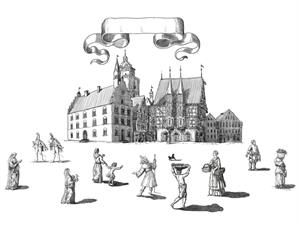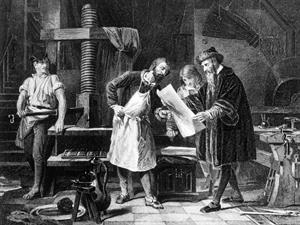PDF chapter test TRY NOW
Introduction:
The Modern Age in Europe began after the culmination of the Middle ages, which can be interpreted from the second half of the 15^{th} Century to the advent of rapid Industrialisation in the latter half of the 18^{th} Century.
This period also witnessed the dramatic events that further shaped the dynamics of Europe. The rise of the concept of “Renaissance” brought substantial changes in Economic, Political and Cultural Spheres.
Age-old systems and hierarchies perished under the new wave of Intellectual thoughts and principles that swept the European nations in the 16^{th} Century.
Many factors played a crucial role in shaping the course of Modern Europe, and some of the notable ones are listed below.
1. Economy and Trade
2. The advent of Printing
3. Fall of the Eastern European Empire
Medieval Europe was also highly dependent on agriculture like all the other pre-Industrial countries. The later part of the Middle Ages saw the fall of the Feudal style of Economy, and slowly Europe moved towards embracing Urbanisation.
Trade via Sea was the most viable option, followed by the traders as it was cheaper than the land routes. The Coasts and Rivers of Europe aided the transportation of goods to and fro from the towns.
The North and Mediterranean Seas were the most important routes where international trade flourished. 
The Jews held most of the financial wealth in the Middle East and Europe. The Italian cities also accrued wealth and slowly became part of the banking institutions.
The Invention of the Movable Type Printing press shifted the growth of Medieval Europe in numerous ways. “Johannes Gutenberg”, a German Goldsmith, invented the Printing Press in 1436. 
The Seljuk Turks faced the wrath of the Mongol empire and lost many of its territories. The Ottomans who were seeking asylum in the Seljuq empires rose to the occasion when the Seljuk's power went on the wane.
Most of the Skilled artisans, craftsmen and scholars left Constantinople and were sheltered in Italy City-States.
The Renaissance movement, which strengthened during the 16^{th} century across Europe, ignited the minds of people through intellectual thoughts.
The Modern Age in Europe began after the culmination of the Middle ages, which can be interpreted from the second half of the 15^{th} Century to the advent of rapid Industrialisation in the latter half of the 18^{th} Century.
This period also witnessed the dramatic events that further shaped the dynamics of Europe. The rise of the concept of “Renaissance” brought substantial changes in Economic, Political and Cultural Spheres.
Age-old systems and hierarchies perished under the new wave of Intellectual thoughts and principles that swept the European nations in the 16^{th} Century.
Factors that led to the revival:
Many factors played a crucial role in shaping the course of Modern Europe, and some of the notable ones are listed below.
1. Economy and Trade
2. The advent of Printing
3. Fall of the Eastern European Empire
1. Economy and Trade:
Medieval Europe was also highly dependent on agriculture like all the other pre-Industrial countries. The later part of the Middle Ages saw the fall of the Feudal style of Economy, and slowly Europe moved towards embracing Urbanisation.
Trade via Sea was the most viable option, followed by the traders as it was cheaper than the land routes. The Coasts and Rivers of Europe aided the transportation of goods to and fro from the towns.
The North and Mediterranean Seas were the most important routes where international trade flourished.
Mediterranean Region: The Term Mediterranean is derived from the Latin word “Mediterraneus” which means the “Middle Land”. This region spreads from the Atlantic Ocean in the West to Asia in the East. It is also called the “Cradle of Western Civilisation”.
The Arabs from the East brought Slaves, Spices, Ivory, and Gold to the Italian City-States of Pisa, Genoa, Amalfi and Venice, which flourished through the emergence of new markets.

Old Town of Europe
The rise in trade paved the way for the emergence of Banking institutions in Italy. During the earlier period, the Jewish community controlled the financial and banking institutions.
The Jews held most of the financial wealth in the Middle East and Europe. The Italian cities also accrued wealth and slowly became part of the banking institutions.
2. The Advent of Printing:
The Invention of the Movable Type Printing press shifted the growth of Medieval Europe in numerous ways. “Johannes Gutenberg”, a German Goldsmith, invented the Printing Press in 1436.

Gutenberg in his Press
The Printing Press pulled Europe and the rest of the world from its Dark Age by the proliferation of Knowledge and the happenings from different parts of the countries.
Vellum: These are Calf Skin used for writing and Binding of Books in earlier periods before the advent of the Printing press.
The Invention also brought a new network of News which spread the happenings on one part of Europe to the Other part of Europe. Printing of Books, Pamphlets etc., rediscovered the spread of Knowledge in Europe.
3. Fall of the Eastern European Empire:
The Seljuk Turks faced the wrath of the Mongol empire and lost many of its territories. The Ottomans who were seeking asylum in the Seljuq empires rose to the occasion when the Seljuk's power went on the wane.
Ottoman: The word Ottoman was derived from its founder, “Osman I” who established the empire in 1299 in Anatolia.
Mohammed II, the ruler of the Ottoman Empire, invaded and conquered “Constantinople”, the capital city of the Byzantine empire in 1453, which ended the reign of the empire in Eastern Europe.
Most of the Skilled artisans, craftsmen and scholars left Constantinople and were sheltered in Italy City-States.
The Renaissance movement, which strengthened during the 16^{th} century across Europe, ignited the minds of people through intellectual thoughts.
